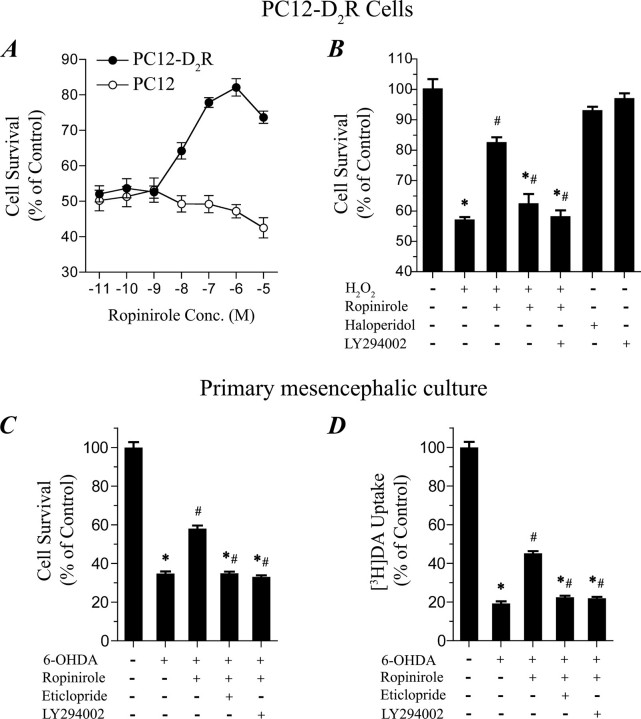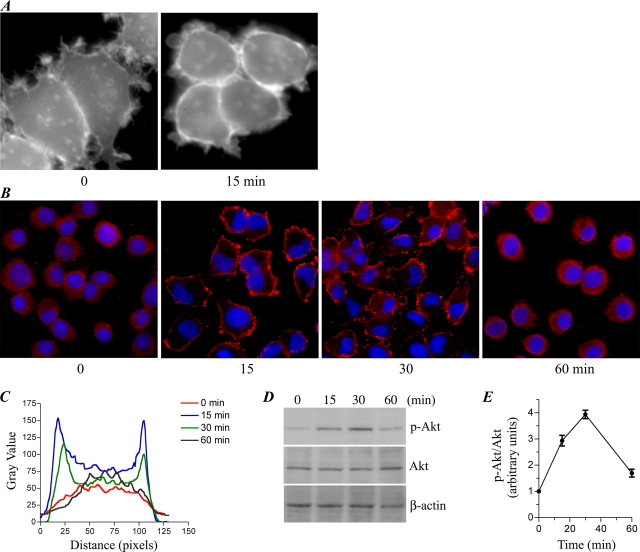
| Size | Price | Stock | Qty |
|---|---|---|---|
| 25mg |
|
||
| 50mg |
|
||
| 100mg |
|
||
| 250mg |
|
||
| 500mg |
|
||
| 1g |
|
||
| Other Sizes |
|
Ropinirole (also known as AS-041164; SKF101468; Requip) a potent and selective dopamine D2 receptors agonist (Ki = 29 nM) of the non-ergoline class of medications with anti-PD effects. Ropinirole is mainly used for Parkinson's disease, RLS-restless legs syndrome and extrapyramidal symptoms. Additionally, it can lessen the side effects of selective serotonin reuptake inhibitors (SSRIs) and antipsychotics, such as Parkinsonism syndrome, erectile dysfunction, and sexual dysfunction. In the Fe2+–H2O2 reaction system, ropinirole scavenges free radicals and inhibits lipid peroxidation.
| Targets |
D2 Receptor ( Ki = 29 nM ); hD2 Receptor ( pEC50 = 7.4 ); hD3 Receptor ( pEC50 = 8.4 ); hD4.4 Receptor ( pEC50 = 6.8 )
|
|
|---|---|---|
| ln Vitro |
|
|
| ln Vivo |
|
|
| References |
| Molecular Formula |
C16H24N2O
|
|---|---|
| Molecular Weight |
260.37456
|
| Exact Mass |
260.19
|
| Elemental Analysis |
C, 73.81; H, 9.29; N, 10.76; O, 6.14
|
| CAS # |
91374-21-9
|
| Related CAS # |
Ropinirole hydrochloride; 91374-20-8; Ropinirole-d14; 1132746-05-4
|
| Appearance |
Solid powder
|
| SMILES |
CCCN(CCC)CCC1=C2CC(=O)NC2=CC=C1
|
| InChi Key |
UHSKFQJFRQCDBE-UHFFFAOYSA-N
|
| InChi Code |
InChI=1S/C16H24N2O/c1-3-9-18(10-4-2)11-8-13-6-5-7-15-14(13)12-16(19)17-15/h5-7H,3-4,8-12H2,1-2H3,(H,17,19)
|
| Chemical Name |
4-[2-(dipropylamino)ethyl]-1,3-dihydroindol-2-one
|
| Synonyms |
Ropinirole; AS-041164; SKF 101468; AS 041164; SKF-101,468; AS041164; SKF 101468
|
| HS Tariff Code |
2934.99.9001
|
| Storage |
Powder -20°C 3 years 4°C 2 years In solvent -80°C 6 months -20°C 1 month |
| Shipping Condition |
Room temperature (This product is stable at ambient temperature for a few days during ordinary shipping and time spent in Customs)
|
| Solubility (In Vitro) |
May dissolve in DMSO (in most cases), if not, try other solvents such as H2O, Ethanol, or DMF with a minute amount of products to avoid loss of samples
|
|---|---|
| Solubility (In Vivo) |
Note: Listed below are some common formulations that may be used to formulate products with low water solubility (e.g. < 1 mg/mL), you may test these formulations using a minute amount of products to avoid loss of samples.
Injection Formulations
Injection Formulation 1: DMSO : Tween 80: Saline = 10 : 5 : 85 (i.e. 100 μL DMSO stock solution → 50 μL Tween 80 → 850 μL Saline)(e.g. IP/IV/IM/SC) *Preparation of saline: Dissolve 0.9 g of sodium chloride in 100 mL ddH ₂ O to obtain a clear solution. Injection Formulation 2: DMSO : PEG300 :Tween 80 : Saline = 10 : 40 : 5 : 45 (i.e. 100 μL DMSO → 400 μLPEG300 → 50 μL Tween 80 → 450 μL Saline) Injection Formulation 3: DMSO : Corn oil = 10 : 90 (i.e. 100 μL DMSO → 900 μL Corn oil) Example: Take the Injection Formulation 3 (DMSO : Corn oil = 10 : 90) as an example, if 1 mL of 2.5 mg/mL working solution is to be prepared, you can take 100 μL 25 mg/mL DMSO stock solution and add to 900 μL corn oil, mix well to obtain a clear or suspension solution (2.5 mg/mL, ready for use in animals). View More
Injection Formulation 4: DMSO : 20% SBE-β-CD in saline = 10 : 90 [i.e. 100 μL DMSO → 900 μL (20% SBE-β-CD in saline)] Oral Formulations
Oral Formulation 1: Suspend in 0.5% CMC Na (carboxymethylcellulose sodium) Oral Formulation 2: Suspend in 0.5% Carboxymethyl cellulose Example: Take the Oral Formulation 1 (Suspend in 0.5% CMC Na) as an example, if 100 mL of 2.5 mg/mL working solution is to be prepared, you can first prepare 0.5% CMC Na solution by measuring 0.5 g CMC Na and dissolve it in 100 mL ddH2O to obtain a clear solution; then add 250 mg of the product to 100 mL 0.5% CMC Na solution, to make the suspension solution (2.5 mg/mL, ready for use in animals). View More
Oral Formulation 3: Dissolved in PEG400 (Please use freshly prepared in vivo formulations for optimal results.) |
| Preparing Stock Solutions | 1 mg | 5 mg | 10 mg | |
| 1 mM | 3.8407 mL | 19.2034 mL | 38.4069 mL | |
| 5 mM | 0.7681 mL | 3.8407 mL | 7.6814 mL | |
| 10 mM | 0.3841 mL | 1.9203 mL | 3.8407 mL |
*Note: Please select an appropriate solvent for the preparation of stock solution based on your experiment needs. For most products, DMSO can be used for preparing stock solutions (e.g. 5 mM, 10 mM, or 20 mM concentration); some products with high aqueous solubility may be dissolved in water directly. Solubility information is available at the above Solubility Data section. Once the stock solution is prepared, aliquot it to routine usage volumes and store at -20°C or -80°C. Avoid repeated freeze and thaw cycles.
Calculation results
Working concentration: mg/mL;
Method for preparing DMSO stock solution: mg drug pre-dissolved in μL DMSO (stock solution concentration mg/mL). Please contact us first if the concentration exceeds the DMSO solubility of the batch of drug.
Method for preparing in vivo formulation::Take μL DMSO stock solution, next add μL PEG300, mix and clarify, next addμL Tween 80, mix and clarify, next add μL ddH2O,mix and clarify.
(1) Please be sure that the solution is clear before the addition of next solvent. Dissolution methods like vortex, ultrasound or warming and heat may be used to aid dissolving.
(2) Be sure to add the solvent(s) in order.
| NCT Number | Recruitment | interventions | Conditions | Sponsor/Collaborators | Start Date | Phases |
| NCT03176966 | Completed | Drug: Vitamin E Drug: Ropinirole |
Muscle Cramp Cirrhosis |
Vanderbilt University Medical Center |
September 2, 2016 | Phase 4 |
| NCT00823836 | Completed | Drug: ropinirole PR/XR Drug: ropinirole IR |
Parkinson Disease | GlaxoSmithKline | March 2009 | Phase 3 |
| NCT01627834 | Completed | Drug: Ropinirole | Healthy | Dr. Reddy's Laboratories Limited |
October 2009 | Phase 1 |
| NCT01627847 | Completed | Drug: Ropinirole | Healthy | Dr. Reddy's Laboratories Limited | October 2009 | Phase 1 |
| NCT03038308 | Completed | Drug: Ropinirole | Hyperprolactinemia Prolactinoma |
Columbia University | September 16, 2016 | Phase 1 Phase 2 |
 |
|---|
  |
 |